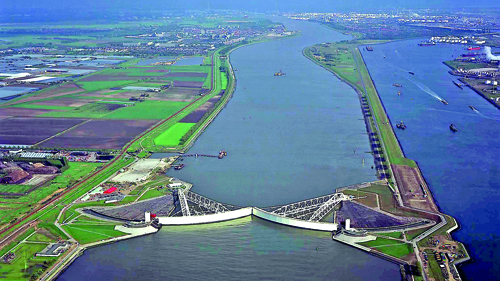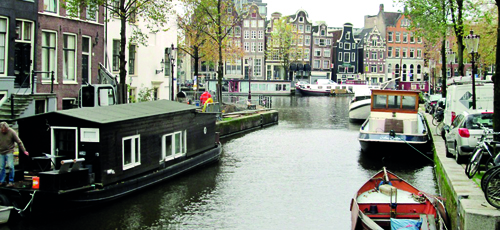Netherlands looks beyond dykes for flood protection
We braced ourselves against the biting wind and followed the guide down to the river. “Don’t worry about the gear,” she said, pointing to her neon orange jacket and hardhat. “This is just procedure. It’s perfectly safe out here.”It was drizzling again. They hadn’t been kidding when they said it always rained in the Netherlands. We turned a corner and there it was: One of the largest moving structures on the planet, the Maeslant Storm Surge Barrier.
This Dutch engineering marvel is a giant floodgate that closes off the river from the sea when water rises above a specified level. It could happen during a storm, when wind and atmospheric pressure causes the sea to surge.

Picture courtesy Rijkswaterstaat shows the Maeslant barrier when it is closed, separating the sea from the river.
Or when there is spring tide, just after a full moon.
Two arms of 740 feet each automatically swing together, blocking off the 1,181-feet wide waterway. The structure is almost as long as the Eiffel Tower and weighs about four times as much. This is flood protection at its best, keeping the port of Rotterdam and around one million people in southern Holland safe from the sea.
But the barrier is only part of a larger plan called the Delta Works, a series of construction projects in southwest Netherlands designed to defend large areas of land from the sea. These include dams, sluices, dykes, levees, and other storm surge barriers.
Much of this is necessary because 26 per cent of the country is below sea level while 29 per cent is susceptible to river flooding. No wonder, then, that the Dutch are experts in flood-control. At any given time of year, there are ongoing projects in numerous parts of the Netherlands designed to protect the country from inundation.
Technology keeps evolving; the knowledge base continues to expand.
Crucially, the Dutch populace cooperates with authorities who, in turn, ensure that people are kept informed of and involved in every initiative.
They also contribute significant taxes towards national efforts. For example, every house pays a water safety tax and a fee to compensate for water pollution, calculated on the number of occupants.
The Dutch aren’t all about flood-protection, though. Their government has identified water as a “top sector” and is pushing it across the globe through a policy of economic diplomacy. They are well-positioned to do so.

Amsterdam canals. Pic by Namini Wijedasa
Ten of the world’s best engineering firms in the field of water are from the Netherlands. So are two world leaders in land reclamation, dredging and coastal construction.
Many private companies actively promote water re-use and purification. The country also has robust NGOs, research institutes, universities and local government working in the industry.
According to the Ministry of Economic Affairs, approximately 1,500 companies are directly active in water technology in the Netherlands. Another 450 are indirectly involved. Dutch water technology companies generate an annual turnover of 17 billion Euros, of which nearly 40 per cent is earned abroad.
An astounding 99.9 per cent of Dutch households have access to clean drinking water which is entirely chlorine-free.
Today, the Dutch are eager to market their know-how to the world—and the world is buying. For instance, navigable storm surge barriers are being considered for New York which was inundated in Hurricane Sandy. Dutch hydraulic experts and officials have moved to the US to advise the authorities there on flood control.The combined Dutch Water Partnership has 252 projects abroad. Among them are river basin management in upper Niger; hurricane risk reduction in New Orleans; use of brackish water for potato cultivation in Egypt; climate adaptation, including relocation of a port, in Ho Chi Minh City, Vietnam; and the removal of iron from well water in Moscow.
On the list is also an innovative pilot project in Bangladesh that uses oysters as a defence against coastal flooding and erosion. Molluscs provide natural resistance to water flow while doubling up as a food source.
The many areas of Dutch expertise are mindboggling. Holland Branding recently organized a five-day tour of the Netherlands for journalists.
Commissioned by the Dutch Ministry of Foreign Affairs, it brought together reporters from India, Sri Lanka, Singapore, Croatia and Panama.
One of the most impressive projects we were shown was the multi-million Euro ‘Room for the River’ initiative. Its objective is to protect four million inhabitants—many of whom live behind dykes constructed to confine the rivers—from overflow.
Dykes are a centuries-old safeguard against rivers bursting their banks. But the Dutch have concluded that these would be inadequate in the future, particularly with climate change and rising water levels. The area available for rivers has decreased over the years and the land behind the dykes has sunk due to soil subsidence. It now rains harder and more frequently, causing the rivers to discharge more water to the sea.
It was decided against building the dykes taller and stronger. In fact, this could cause worse damage since more water would flow into the sunken land behind them. The Dutch settled instead on a ‘Room for the River’ concept which would give the Rhine, Neuse, Waal and Ijssel rivers “more space” at 39 locations.
Among the strategies being adopted is a shifting of dykes from their current locations so that the floodplains become wider; a strengthening of dykes; a deepening of river beds; increasing the depth of existing side channels as well as creating new ones; and removing obstacles to the water flow. In some areas, the landscape is being changed to allow for flooding.
One of the places at which some of these measures are being implemented is the beautiful city of Nijmegen which we visited. At 2000 years old, it is also Holland’s oldest city. The waterway in question was the River Waal.
“We are changing the scenario from defending against the river to adapting to the river,” explained Karsten Shipperheijn, project manager in the area.
“You must have good dykes and room for the river.”
We slipped on some wellington boots and plodded onto the vast construction site. A new dyke was being built and an old bridge extended. An island will be created along with a new channel and an urban river park. Fifty Nijmegen households are to be relocated while the entire Room for the River project requires 200 families to move.
We ate lunch—steaming Dutch broodje krokets or veal ragout-filled rolls between bread—at the Café Waalzicht. Its owner says he will also have to shift but intends to upsize his operation once it is set up on the new island.
The scale of these projects is enormous. Room for the River requires a massive investment running into billions of Euros. But the authorities calculate that more money will be saved in the long-term. In everything that they do, the Dutch are planning for future generations.
| SL-Netherlands cooperation in water management The Dutch Government through the Netherlands Embassy in Colombo is promoting cooperation with Sri Lanka in the fields of water and sanitation. The mission has commissioned two studies in each of the sectors to identify opportunities for bilateral activity. Sri Lanka’s Minister of Water Supply and Drainage Dinesh Gunawardena says there is great scope for cooperation with the Dutch. “Their technology is highly advanced,” he told the Sunday Times. “One area we are interested in is wastewater recycling. It is essential today, with cities and hotels coming up fast.” “Wastewater recycling has already been started in one or two places,” he said. “We are now about to introduce some regulations for the technology to be brought in.” Similarly, Sri Lanka requires sewage treatment solutions, the minister said. “Our processes need to be upgraded,” he admitted. “At present, sewage is just sent into the middle of the sea after one treatment cycle. The Dutch have technology to treat it further. It produces byproducts such as fertilizer or gas and energy which can be sold to the grid, thereby cutting down costs in the private and public sectors.” Sri Lanka unnecessarily uses treated water for construction purposes. “The Dutch have long-distance, portable pipelines that are not made of metal but of some other material,” he explained. “We can use these to transport untreated water from rivers to construction sites, thus saving tremendously on treated water.” In the sphere of water management, sand-mining in rivers has caused environmental problems. “Dutch companies are involved in sea-sand mining so this is another area where their expertise could be sought,” Minister Gunawardena said. “Then, of course, there is land reclamation,” he continued. “Sri Lanka has a problem of salinity going up some rivers now. You see it at Kelaniya, Matara, Kalutara and so on. This has to be handled. The Dutch are well versed in the subject and have also developed technology to protect against coastal and other forms of erosion.” Sri Lanka could also use cooperation in river basin management, wetland protection, forestry and conservation of water sources, the Minister said, pointing towards the possibility of a fruitful economic partnership with Holland. |
|



